Vet Med Students Gain Knowledge, Skills During Summer Research Training Program
August 24, 2016
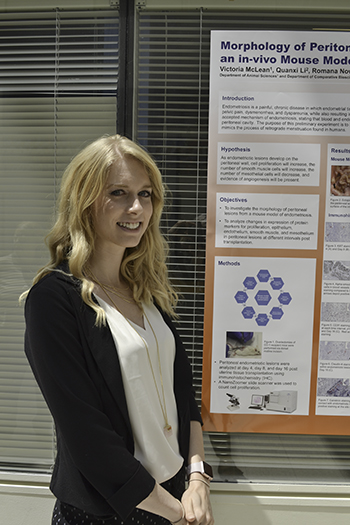
Third Year Vet Med student Victoria McLean presents her research at Vet Med's end-of-summer poster sesion.
This past summer, 14 Illinois Veterinary Medicine (Vet Med) students participated in the 2016 College of Veterinary Medicine Summer Research Training Program, which provided students a chance to get hands-on research experience in their prospective fields and also gave many of them a better idea of what they want to pursue regarding their future careers. Over the course of the summer (May 23–July 29, 2016), participants not only learned a great deal about the area they were researching, developed new skills and techniques which will be beneficial both in their college and professional careers, but grew personally as well.
Run by Professor Lois Hoyer, and funded by NIH (the National Institutes of Health) and Merial, the program also offered special training in some research-related areas. Some training was specific to their research areas, other training was quite practical, such as designing and presenting a poster—skills participants immediately called on while presenting their research during a VetMed poster session on July 27 and at the Merial-NIH Veterinary Scholars Symposium at Ohio State University on July 28—31, 2016. In addition to the skills they acquired, some students grew personally, gaining patience or self-confidence.
Eric Ledesma
One student who grew both professionally and personally this summer was Eric Ledesma, who will be his third year of Veterinary Medicine's 4-year program this fall. He had never done research prior to his work this summer researching equine Osteochondrosis (OC). A developmental disease that affects the joints of horses, OC causes fractures to occur because the bones don't harden. Ledesma's research involved validating SNPs (single nucleotide polymorphisms) expected to be associated with the disease, and discovering any novel (brand new) SNPs. His results? He found two novel SNPs, but still has more to do in terms of the genetic sequencing.
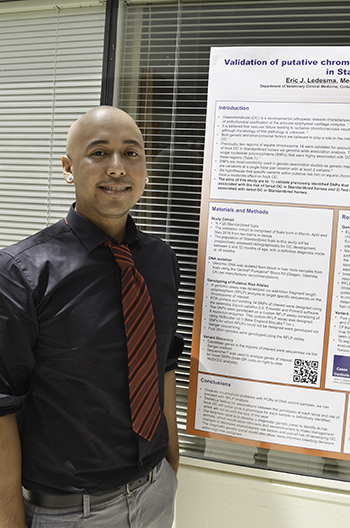
Third Year Vet Med student Eric Ledesma.
While Ledesma’s immediate goal is to become a veterinarian, his ultimate career goal is to bring animal abusers to justice:
“I’ve worked with a lot of shelter animals; I’ve worked with animals that have been abused, so I want to go into anatomical histopathology where I can learn how to perform necropsies [a necropsy in the veterinarian world = an autopsy in human medicine] on animals that come to, say, the ASPCA, and figure out, ‘What happened to this dog?’ ‘What happened to this cat?’ and help find evidence that may help put their abusers away in jail.”
He doesn't know where he might work exactly...could be in an animal shelter, the ASPCA, or academia: “I just want to make sure veterinary forensics will be a part of my career.”
Ledesma learned more than just equine OC research this summer, he learned patience. “I guess I’m just so used to seeing results right away,” he admits, “so I’ve learned to be a little more patient. This whole thing, it’s a whole process. It takes a lot of planning out, a lot of designing. I guess it was hard to stomach that I have to expect bad results initially, because things may not work out as well as you had hoped.”
Personally, he says he also gained more confidence. “I come from a background where I don’t really see veterinarians who look like me, or even hear too much about this type of work where I’m from. So I guess just having the confidence that I can do this, that I’ve learned how to do this, that this was possible for me, it’s possible for anyone else, and I can’t wait to go back home (Jersey City, New Jersey) and show younger students, students in undergrad who look like me that they can do something like this.”
Another aspect of the summer Ledesma appreciated? The exposure to horses. “I had a lot of fun learning about this and working with Dr. McCoy. I’ve never really worked with horses before. I come from an urban environment, so just basically dogs and cats and the occasional reptile or ferret here and there. So it was a treat getting to work with horses—especially foals, baby horses.”
Danielle Engel
Another student who experienced research for this first time this summer was Danielle Engel, who’s going into her second year of vet school. She calls the experience “overwhelming at first, but it was a lot of fun,” she acknowledges.
Engel’s research involved analyzing the effect of protein diets on weight management and bodily metabolism. “We saw that treatment diets specifically didn’t have an effect,” she admits, “but we saw that protein in general had an effect. We saw changes that might change into weight management.”
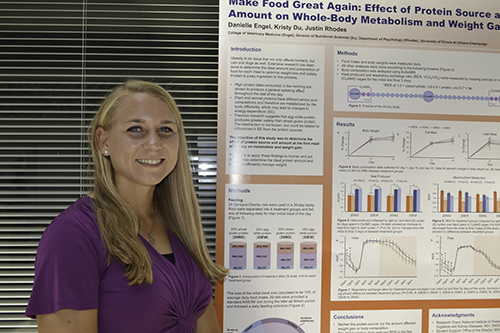
Second Year Vet Med student Danielle Engel
Some skills she learned this summer were related to presenting research and data analysis.
“I learned a lot of presentation of research, just through the poster and the manuscript,” Engel says. “I also helped my grad student analyze a lot of the data. So I learned how to translate it from just numbers into something that might mean something.”
Engel doesn’t want a career in general practice, but some type of specialization. “And after this summer, I kind of want to do research,” she acknowledges.
If she does, it would be research about animals. “I want to research something more organic or animal based, not microbiology,” she admits. “I want to see something that has a direct effect on animals. That’s about all I know right now.”
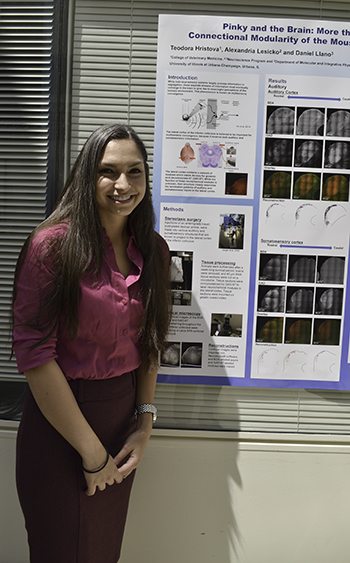
Third Year Vet Med student Teodora Hristova presenting her research on the inferior colliculus during Veterinary Medicine's July 27th poster session.
Teodora Hristova
Teodora Hristova, a third year Vet Med student, says this summer was also her first research experience, and she really enjoyed it: “It was a really good experience,” she says. “Coming into this research project, I only knew where the inferior colliculus was, I didn’t know anything about it, and I learned a bunch about what it does and certain structures associated with it." According to Hristova, it’s a structure associated with hearing.
Hristova discusses her results: “Our hypothesis was that the auditory inputs terminate outside of the modules of the lateral cortex and the inferior colliculus, and the sensory inputs terminate inside the modules,” she explains. Hristova says that after processing the images using special software, “The reconstructions I did showed that our hypothesis was correct.” However, they also got some unexpected results, “It’s obviously a more complicated mechanism…that we would have to look at.”
Hristova says she also gained some new skills: “I learned how to use a microtome. I got to do a brain surgery on a mouse, which is very exciting. So it was nice to practice on my surgical skills before I head into junior surgery, even though my patients will be much bigger. I got to use a different software.”
How does one do surgery on a mouse’s teeny-tiny brain? “You do have a microscope so you can look at exactly where you’re drilling,” Hristova explains, “and there’s an atlas that you use to define where the coordinates are before you drill into the skull and then inject the tracer. And then we used a regular suture to close the skin. It was very interesting.”
Hoping to become a board-certified anesthesiologist, Hristova thinks research will be “a part of what I want to do, not all of it.” Her career goal is to be “a clinical instructor, possibly do research projects on the side...and possibly stay in academia.”
Caitlin Ondera
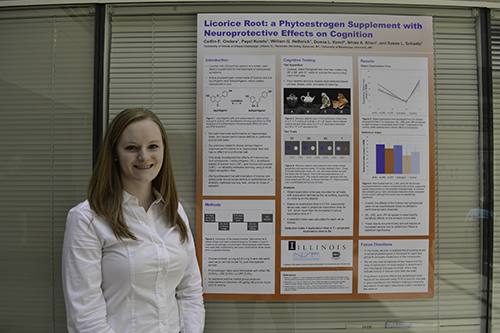
Second Year Vet Med student Caitlin Ondera.
Like Hristova, second year veterinary student Caitlin Ondera also hopes for a career in academia.
“Overall, my career goal is to do an internship in small animal emergency and critical care, and hopefully a residency after that. They have internships in specialty practices or at a university.” Ondera says she’s “hoping to go the academic route, where she can do a Master’s degree at the same time.”
Ondera’s research compared phytoestrogen supplements to traditional estrogen supplements for women. She investigated the cognitive effects on the striatum caused by dosing with licorice root compound, which is a phytoestrogen supplement.
According to Ondera, the study showed that “the phytoestrogen route caused beneficial effects to the striatal task that we performed. And when compared to traditional estrogen supplement, which causes deficits, we found that it has promising effects. Hopefully we can show that’s it’s a safer treatment for women.”
Ondera says she also learned a lot about the use of animals in research this summer. “There are a lot of negative connotations about the use of animals in research,” she explains. “But we learned about all the requirements needed to gain grant money and be able to use animals for studies. We are using rats for our studies.”
Ondera definitely thinks research might be in her future. “I really love doing research. That’s one of the reasons I hope to get an academic position—to help further the field, investigate new directions with the field.”
Zachary Osterholz
For other students, like Zachary Osterholz, a second year Vet Med student this fall, this summer was not his first research experience. Even though he’s been doing research all through undergrad, Osterholz thought the research this summer was great. “The program was really nice as a refresher. We got together as a group once a week to discuss various aspects for research.”
While Osterholz says he also learned a lot of new skills this summer, he stresses that it served as a refresher for some of his previous skills. “A lot of refreshers on genetics, so basic stuff. Stuff I haven’t done in 3-4 years. It was great as a brush up, and hopefully I can keep working so I don’t lose the fresh polished techniques that I have now.”
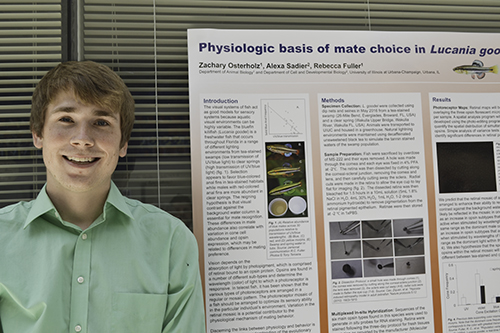
Second Year Vet Med student Zachary Osterholz.
Osterholz’s research was trying to understand the physiological basis of mate choice in small fish. “So what we’re trying to do is link a behavior preferring males of particular color to a molecular level variation. So the cells in their eyes have different types of chemicals that absorb light, and we’re trying to determine if the number of cells of a particular color determine their preference for a male of a specific color.”
Osterholz particularly appreciated being in charge of his own project. “I’ve done a lot of research, and you have a lot more mentorship, and I liked taking ownership and being in charge of my own project.” Osterholz says the project was a win-win for both him and his PI. “This project would help her research as well as satisfy my interests, so it was beneficial to both of us.”
Osterholz’ tastes in animals tend toward the wild side—no dogs and cats for him. “Ideally, I want to work with exotic species. It’s a really competitive world in exotic species, so I’ll take anything I can get. I really enjoy epidemiology, so I would love to work for a government agency doing management of wild populations or for a zoo on the conservation side of their programs.”
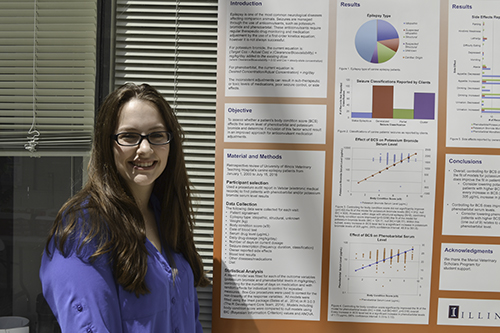
Third Year Vet Med student Chelsea Randall.
Chelsea Randall
Another Vet Med student whose tastes lean toward the exotic species is Chelsea Randall, who will be a third year veterinary student this fall. As to her career plans, she’s still deciding. She'd like a private practice working with exotics—guinea pigs, snakes, birds, etc.—but she’s also considering doing a neurology internship and residency. Randall also might go into research.
“Possibly. Yes. I’m actually gonna work on another project that is more wildlife, so hopefully that will go well.
This summer was not her first research experience; Randall says she researched feline nutrition as an undergrad. This summer’s research, sponsored by Mariel, involved looking at whether a subject’s body condition score had an effect on the serum drug levels of potassium bromide, in an effort to make a better adjustment formula, so the subject would be better covered with their current dosage. “A body condition score is a way to assess the amount of lean-muscle-to-fat ratio,” she explains. “So we have a 9-point scale. Can you feel the ribs or are they more of a round shape?”
What new skills did she gain this summer? “I definitely learned a lot about epilepsy,” Randall says. She also learned some very practical things: “How to write a paper, make a poster, and share with other people what I learned this entire summer.”
Victoria McLean
Like Osterholz and Randall, second year Vet Med student Victoria McLean’s taste in animals also leans toward the wild side—she wants a career as a zoo veterinarian. However, she’s also very interested in the subject matter of her summer research—reproduction—which she hopes to apply to her work with exotic species. “This is a great experience for me to learn more about the reproductive system in any species,” she says, “And hopefully I can use what I learn here and work in reproductive techniques in endangered species.”
McLean spent the summer studying endomeiosis, a disease that occurs in 6–10% of women, where the endometrium, a layer of the uterus, ends up in the abdomen. This causes infertility and lots of other problems. Retrograde menstruation, the title of her presentation, is the theory on how it happens: endometrial tissues move up instead of down during menstruation.
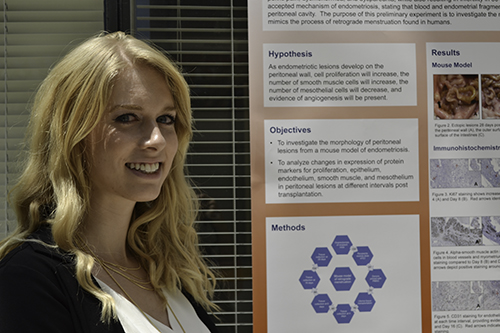
Third Year Vet Med student Victoria McLean.
In their study, they used mice (very easy to use in the lab, according to McLean), taking tissue from the donor mouse and transplanting it into the recipient. “It’s a complete mimic of that in humans,” she explains. “We used these models to study what is happening with the endometrium. So eventually there might be treatments based on this.”
McLean claims the new skills she gained this summer were “endless.”
“‘Cause I have never done any of this before. Even just organizing this poster. How to speak to people. I also have never had any lab skills before.”
She also really appreciated the chance to do surgery early on in her career at Illinois, “As a second year, you don’t get that much hands-on experience as I eventually will as a fourth year.”
McLean says she will definitely be doing research in the future. “To be a zoo veterinarian, I have to do research and publish to get that job."
So how can a student studying to be a zoo veterinarian use the animals primarily studied here (small animals, like dogs and cats, and larger ones, like cows and horses?) to prepare for more exotic zoo animals, which are much different, like, say, a lion? McLean says that’s not an issue.
“We have a really good program here, which is why I chose U of I. I work in the wildlife medical clinic where every day we see cases with different species of wildlife that the public brings in, so I get tons of experience that way. The species aren’t exotic, but they are similar. For example, we worked with a bobcat this summer. That is comparable to working with a tiger or a lion.”
In fact, there’s a zoo department here in the Vet School: “Animals are brought in from the zoo,” she explains, “and my mentor is a zoo vet himself, and he works part time here. So I’m learning a lot from him as well, and this is where I need to be.”
Author and Photographer: Elizabeth Innes, Communications Specialist, I-STEM Education Initiative
For more related stories, see: Funded, Summer Research, Vet Med, 2016
For additional I-STEM articles about Veterinary Medicine, see:













.jpg)
















